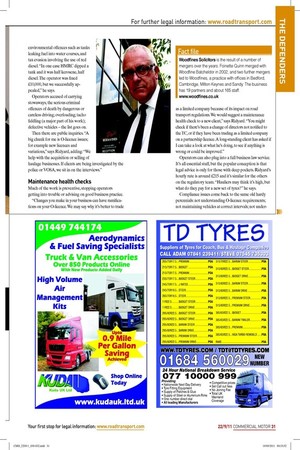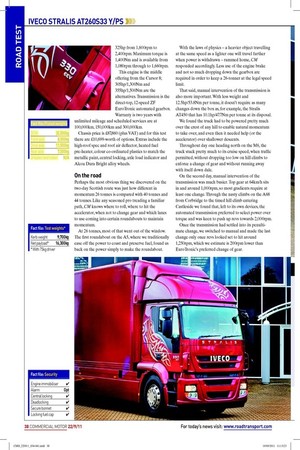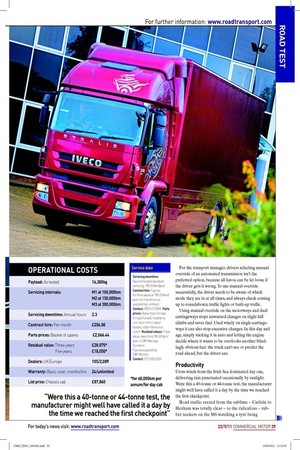Fact file
Page 19

Page 23

Page 24

If you've noticed an error in this article please click here to report it so we can fix it.
Woodfines Solicitors is the result of a number of mergers over the years. Foinette Quinn merged with Woodfine Batcheldor in 2002, and two further mergers led to Woodfines, a practice with offices in Bedford, Cambridge, Milton Keynes and Sandy. The business has 19 partners and about 165 staff. www.woodfines.co.uk environmental offences such as tanks leaking fuel into water courses, and tax evasion involving the use of red diesel. “In one case HMRC dipped a tank and it was half kerosene, half diesel. The operator was ined £10,000, but we successfully ap pealed,” he says.
Operators accused of carrying stowaways; the serious criminal offences of death by dangerous or careless driving; overloading; tacho iddling (a major part of his work); defective vehicles – the list goes on.
Then there are public inquiries. “A big chunk for me is O-licence issues; for example new licences and variations,” says Ridyard, adding: “We help with the acquisition or selling of haulage businesses. If clients are being investigated by the police or VOSA, we sit in on the interviews.”
Maintenance health checks
Much of the work is preventive, stopping operators getting into trouble or advising on good business practice. “Changes you make in your business can have ramiications on your O-licence. We may say why it’s better to trade as a limited company because of its impact on road transport regulations. We would suggest a maintenance health check to a new client,” says Ridyard. “You might check if there’s been a change of directors not notiied to the TC, or if they have been trading as a limited company on a partnership licence. A long-standing client has asked if I can take a look at what he’s doing, to see if anything is wrong or could be improved.” Operators can also plug into a full business law service. It’s all essential stuff, but the popular conception is that legal advice is only for those with deep pockets. Ridyard’s hourly rate is around £215 and it’s similar for the others on the regulatory team. “Hauliers may think it’s high, but what do they pay for a new set of tyres?” he says.
Compliance issues come back to the same old hardy perennials: not understanding O-licence requirements; not maintaining vehicles at correct intervals; not under 325hp from 1,600rpm to 2,400rpm. Maximum torque is 1,400Nm and is available from 1,080rpm through to 1,660rpm.
This engine is the middle offering from the Cursor 8; 305hp/1,300Nm and 355hp/1,500Nm are the alternatives. Transmission is the direct-top, 12-speed ZF EuroTronic automated gearbox. Warranty is two years with unlimited mileage and scheduled services are at 100,000km, 150,000km and 300,000km.
Chassis price is £87,860 (plus VAT) and for this test there are £10,699-worth of options. Extras include the high-roof spec and roof air delector, heated fuel pre-heater, colour co-ordinated plastics to match the metallic paint, central locking, axle load indicator and Alcoa Dura Bright alloy wheels.
On the road
Perhaps the most obvious thing we discovered on the two-day Scottish route was just how different in momentum 26 tonnes is compared with 40 tonnes and 44 tonnes. Like any seasoned pro treading a familiar path, CM knows where to roll, where to hit the accelerator, when not to change gear and which lanes to use coming into certain roundabouts to maintain momentum.
At 26 tonnes, most of that went out of the window. The irst roundabout on the A5, where we traditionally ease off the power to coast and preserve fuel, found us back on the power simply to make the roundabout. With the laws of physics – a heavier object travelling at the same speed as a lighter one will travel further when power is withdrawn – rammed home, CM responded accordingly. Less use of the engine brake and not so much dropping down the gearbox are required in order to keep a 26-tonner at the legal speed limit.
That said, manual intervention of the transmission is also more important. With less weight and 12.5hp/53.8Nm per tonne, it doesn’t require as many changes down the box as, for example, the Stralis AT450 that has 10.1hp/47.7Nm per tonne at its disposal.
We found the truck had to be powered pretty much over the crest of any hill to enable natural momentum to take over, and even then it needed help (or the accelerator) over shallower descents.
Throughout day one heading north on the M6, the truck stuck pretty much to its cruise speed, when trafic permitted, without dropping too low on hill climbs to enforce a change of gear and without running away with itself down dale.
On the second day, manual intervention of the transmission was much busier. Top gear at 64km/h sits in and around 1,000rpm, so most gradients require at least one change. Through the nasty climbs on the A68 from Corbridge to the timed hill climb entering Castleside we found that, left to its own devices, the automated transmission preferred to select power over torque and was keen to push up revs towards 2,000rpm.
Once the transmission had settled into its penultimate change, we switched to manual and made the last change only once revs looked set to hit around 1,250rpm, which we estimate is 200rpm lower than EuroTronic’s preferred change of gear.
For the transport manager, drivers selecting manual override of an automated transmission isn’t the preferred option, because all havoc can be let loose if the driver gets it wrong. To use manual override successfully, the driver needs to be aware of which mode they are in at all times, and always check coming up to roundabouts, trafic lights or built-up trafic.
Using manual override on the motorways and dual carriageways stops unwanted changes on slight hill climbs and saves fuel. Used wisely on single-carriageways it can also stop excessive changes. In this day and age, simply sticking it in auto and letting the engine decide where it wants to be overlooks another blindingly obvious fact: the truck can’t see or predict the road ahead, but the driver can.
Productivity
Cross winds from the Irish Sea dominated day one, delivering rain punctuated occasionally by sunlight. Were this a 40-tonne or 44-tonne test, the manufacturer might well have called it a day by the time we reached the irst checkpoint.
Road traffic veered from the sublime – Carlisle to Hexham was totally clear – to the ridiculous – rubber neckers on the M6 watching a tyre being




































